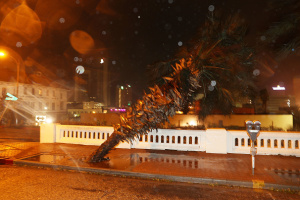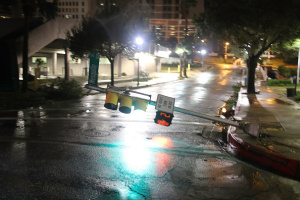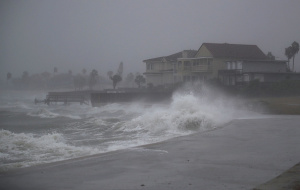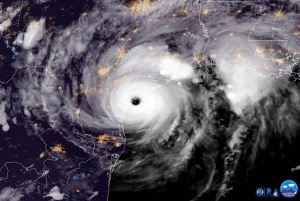- One set of evacuation orders lifted in Caldwell County after wildfire contained
- 'We gutted every building' | Chimney Rock rebuilding after Hurricane Helene
- 'We gutted every building' | Chimney Rock rebuilding after Hurricane Helene
- Debris from Hurricane Helene provides fuel, complicates containment for spring wildfires
- David & Nicole Tepper increase Hurricane Helene relief commitment to $750k
Harvey Downgraded To Category 1 Hurricane, Flood Threat Continues

CORPUS CHRISTI (CBSDFW.COM/AP) — Hurricane Harvey settled over southeast Texas early Saturday, lashing the state’s Gulf Coast with damaging winds and dumping torrents of rain over hundreds of miles of coastline that braced for what forecasters predicted would be life-threatening storm surges — basically walls of water moving inland.
The fiercest hurricane to hit the U.S. in more than a decade made landfall Friday night about 30 miles northeast of Corpus Christi as a Category 4 storm with 130 mph winds. It gradually weakened over the next several hours and the National Hurricane Center said that by 5 a.m. Saturday Harvey was downgraded to a Category 1 — still sustaining winds of 90 mph. By dawn, nearly 300,000 consumers were without power in the Texas coastal region. Nearly 20 inches of rain had fallen in some places.
CORPUS CHRISTI, TX – AUGUST 26: A tree is seen knocked sideways during the passing of Hurricane Harvey on August 26, 2017 in Corpus Christi, Texas. Hurricane Harvey had intensified into a hurricane and hit the Texas coast as damage is being assessed. (Photo by Joe Raedle/Getty Images)
No deaths were immediately confirmed in the hours after Harvey’s arrival, but officials noted emergency crews couldn’t get out in many places due to high winds. Melissa Munguia, deputy emergency management coordinator in Nueces County, which includes Corpus Christi, said early Saturday that it could be hours before crews could fully assess the damage in coastal communities.
Rockport Mayor Charles “C.J.” Wax told The Weather Channel on Saturday that Hurricane Harvey hit his coastal community “right on the nose” and left “widespread devastation.”
He says some homes and businesses were heavily damaged or even completely destroyed. Schools were also damaged. Officials confirmed that the roof of Rockport’s high school had partially caved in and that the community’s historic downtown saw extensive damage.
The emergency response system for the city of about 10,000 people has been hampered by the loss of cellphone service and other forms of communication.
Rockport City Manager Kevin Carruth told local media outlets that multiple people had been taken to the county’s jail for assessment and treatment after the roof of a senior housing complex collapsed. KIII-TV reported that 10 people were treated there.
Earlier Friday, Rockport Mayor Pro Tem Patrick Rios had offered ominous advice, telling the station that those who chose to stay put rather than evacuate the area “should make some type of preparation to mark their arm with a Sharpie pen,” implying doing so would make it easier for rescuers to identify them.

CORPUS CHRISTI, TX – AUGUST 26: A street light is knocked off it’s base by the winds of Hurricane Harvey on August 26, 2017 in Corpus Christi, Texas. Hurricane Harvey had intensified into a hurricane and hit the Texas coast as damage is being assessed. (Photo by Joe Raedle/Getty Images)
In Corpus Christi, the major city closest to the storm’s center, wind whipped palm trees and stinging sheets of horizontal rain slapped against hotels and office buildings along the city’s seawall as the storm made landfall. Boats bobbed violently in the marina. It was too dark to tell whether any boats had broken their moorings.
Fueled by warm Gulf of Mexico waters, Harvey grew rapidly, accelerating from a Category 1 early Friday morning to a Category 4 by evening. Its transformation from an unnamed storm to a life-threatening behemoth took only 56 hours, an incredibly fast intensification.
Harvey came ashore as the fiercest hurricane to hit the U.S. in 13 years and the strongest to strike Texas since 1961’s Hurricane Carla, the most powerful Texas hurricane on record. Based on the atmospheric pressure, Harvey ties for the 18th strongest hurricane on landfall in the U.S. since 1851 and ninth strongest in Texas.
A worst case scenario is that the hurricane could hug the coast for days and stay strong enough to remain a tropical storm. Forecasts call for as much as 30 inches of rain to fall by next Wednesday, with some areas getting as much as 40 inches, according to the hurricane center. Meanwhile, the storm surge could bring flooding of 6 to 12 feet to a coastal area that includes Matagorda Island and Port O’Connor.
Sometime early next week forecasters said it could go back into the warm Gulf of Mexico waters, which provide fuel, then turn back in for a potential second hit on what may be an already flooded Houston-Galveston area.
Before the storm arrived, home and business owners raced to nail plywood over windows and fill sandbags. Steady traffic filled the highways leaving Corpus Christi, but there were no apparent jams. In Houston, where mass evacuations can include changing major highways to a one-way vehicle flow, authorities left traffic patterns unchanged.
Just hours before the projected landfall, the governor and Houston leaders issued conflicting statements on evacuation.
After Gov. Greg Abbott urged more people to flee, Houston authorities told people to remain in their homes and recommended no widespread evacuations.
In a Friday press conference that addressed Houston officials’ decision to not have a voluntary or mandatory evacuation, Houston Mayor Sylvester Turner said there might be a “greater danger” in having people who don’t need to be evacuated on roads that could flood.
Harris County Judge Ed Emmett said that because the hurricane was not taking direct aim at Houston, the city’s primary concern was heavy flooding.
“We are not having a hurricane,” said Emmett, the top elected official for the county, which encompasses Houston. “We are having a rain event.”
At a convenience store in Houston’s Meyerland neighborhood, at least 12 cars lined up for fuel. Brent Borgstedte said this was the fourth gas station he had visited to try to fill up his son’s car. The 55-year-old insurance agent shrugged off Harvey’s risks.
“I don’t think anybody is really that worried about it. I’ve lived here my whole life,” he said. “I’ve been through several hurricanes.”
Scientists warned that Harvey could swamp counties more than 100 miles inland and stir up dangerous surf as far away as Alabama and the Florida Panhandle, 700 miles from the projected landfall.
It may also spawn tornadoes. Even after weakening, the system might spin out into the Gulf and regain strength before hitting Houston a second time Wednesday as a tropical storm, forecasters said.
All seven Texas counties on the coast from Corpus Christi to the western end of Galveston Island ordered mandatory evacuations from low-lying areas. Four counties ordered full evacuations and warned there was no guarantee of rescue for people staying behind.
State officials said they had no count on how many people actually left their homes.

CORPUS CHRISTI, TX – AUGUST 25: Waves pound the shore from approaching Hurricane Harvey on August 25, 2017 in Corpus Christi, Texas. Hurricane Harvey has intensified into a hurricane and is aiming for the Texas coast with the potential for up to 3 feet of rain and 125 mph winds. (Photo by Joe Raedle/Getty Images)
The storm posed the first major emergency management test of President Donald Trump’s administration. The president was expected to receive briefings during the weekend at Camp David, and signed a federal disaster declaration for coastal counties Friday night.
President Donald Trump has commended the head of the Federal Emergency Management Agency for his handling of the hurricane now hitting the Texas Gulf Coast.
In a tweet Saturday morning addressed to FEMA head Brock Long, Trump said: “You are doing a great job – the world is watching! Be safe.”
Hurricane Harvey, the fiercest to hit the U.S. in more than a decade, is posing the first major emergency management test of Trump’s administration.
In a separate tweet, Trump said he is monitoring the hurricane closely from Camp David and “We are leaving nothing to chance. City, State and Federal Govs. working great together!”
He also tweeted that “We have fantastic people on the ground, got there long before #Harvey. So far, so good!”
U.S. Senator John Cornyn (R-TX) today released the following statement after Hurricane Harvey made landfall along the Texas Gulf Coast:
“Our Texas communities affected by this severe hurricane continue to be in my prayers, as are the first responders and emergency personnel who are working around the clock. The threat posed by Harvey is extreme, and Texans should continue to heed the warnings of local officials and emergency personnel.”
“My staff and I will remain in close contact with FEMA, the Governor’s office, and local officials in impacted areas as Texas continues to endure this dangerous storm. Thank you to all Texans who will be helping those in need in the days and weeks ahead.”
The last Category 4 storm to hit the U.S. was Hurricane Charley in August 2004 in Florida. Superstorm Sandy, which pummeled New York and New Jersey in 2012, never had the high winds and had lost tropical status by the time it struck. But it was devastating without formally being called a major hurricane.
Harvey is the first significant hurricane to hit Texas since Ike in September 2008 brought winds of 110 mph to the Galveston and Houston areas, inflicting $22 billion in damage.

UNITED STATES – AUGUST 25: In this NOAA handout image, NOAA’s GOES East satellite capture of Hurricane Harvey shows the storm making landfall shortly after 8:00pm CDT on August 25, 2017 on the mid-Texas coast. Now at category 4 strength, Harvey’s maximum sustained winds had increased to 130 miles per hour. (Photo by NASA/NOAA GOES Project via Getty Images)
It’s taking aim at the same vicinity as Carla, which had wind gusts estimated at 175 mph and inflicted more than $300 million in damage. The storm killed 34 people and forced about 250,000 people to evacuate.
CBS11 has two reporters covering Hurricane Harvey. You can follow them by clicking on Twitter for the latest updates by clicking on these links: Jeff Paul, Jason Allen.
(© Copyright 2017 CBS Broadcasting Inc. All Rights Reserved. The Associated Press contributed to this report.)